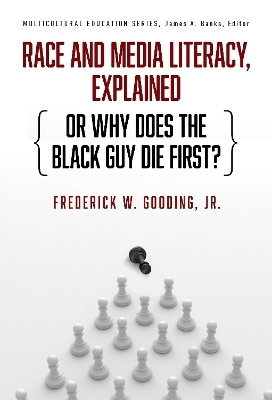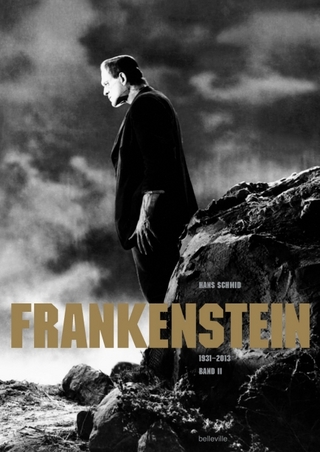
Race and Media Literacy, Explained (or Why Does the Black Guy Die First?)
Teachers' College Press (Verlag)
978-0-8077-6941-6 (ISBN)
Talking about race does not have to be incredibly awkward. In this book, Gooding offers twelve clear, cogent, and concise racial rubrics to help users of mainstream media more readily discern patterns hidden in plain sight. The text primarily leverages popular movies as the medium of analysis—since they are unparalleled in their cultural significance—but the rubrics apply to other forms of media, such as television, print, and social media. “Why does the Black guy die first?” is a well-known rhetorical question that challenges the disparate treatment of non-White characters onscreen. This subtle statement about the representation of persons of color within mainstream movies has remained largely unexplored until now. Race and Media Literacy, Explained provides concrete concepts and a uniform vocabulary with which to recognize and further analyze these formulaic images. After participating in this dynamically interactive experience, readers will never see media the same way again!
Book Features:
An interdisciplinary approach to teaching race that draws on cinema and forms of popular media that most students know.
Guidance for honing media literacy skills with middle, high school, and undergraduate college students.
A HARM Theory Rubric that identifies 6 consistent patterns for depictions of non-White characters and 6 consistent patterns for White characters within mainstream movies.
Questions for Questing sections provide critical questions for further exploration.
Concrete vocabulary/glossary terms to engage with the subject matter more precisely.
Innovative analysis of depictions of race and ethnicity in the top ten highest-grossing films of all time.
Frederick W. Gooding, Jr. is associate professor of African American studies and the Dr. Ronald E. Moore Professor in Humanities in the Honors College at Texas Christian University.
Contents
Acknowledgment xi
Series Foreword James A. Banks xiii
Part I: White Screens, Dark Theaters
Introduction: Evaluating the Worth of a Motion Picture 3
Setting the Stage 3
1,000 Words? 4
Judgment Day 6
Beware Black Engineers 8
Whose Fault? 9
Whose House? 10
The Black Guy Really Does Die First 12
Doing the Math 13
1. Have We Seen This Movie Before? 17
WDF?! (Why Die First?!) 17
But What Is a Mainstream Movie? 20
Take It From the Top 21
Mainstream Racism in Black and White 29
Racism: Now in Living Color 31
2. Value and Visibility 35
Nothing New to Report 35
Introducing the HARM Theory Rubric 38
Sixth Sense: I See White People 41
Seeing (White Hot) Stars 44
The Curious Case of White Women 45
Coming Soon 46
Bottom Line #1 46
Part II: Color Me Bad: Archetypes and Prototypes
3. The Angel Figure Archetype 49
30-Second Spot 49
Trailer 49
Main Feature Analysis 49
Black Mirror 56
Angel Figure Archetype Examples from the Top Ten 57
4. The Background Figure Archetype 61
30-Second Spot 61
Trailer 61
Main Feature Analysis 61
Black Mirror 63
Background Figure Archetype Examples from the Top Ten 64
5. The Comic Relief Archetype 67
30-Second Spot 67
Trailer 67
Main Feature Analysis 68
Black Mirror 69
Comic Relief Archetype Examples from the Top Ten 70
6. The Menace to Society Archetype 75
30-Second Spot 75
Trailer 75
Main Feature Analysis 75
Black Mirror 76
Menace to Society Archetype Examples from the Top Ten 77
7. The Physical Wonder Archetype 81
30-Second Spot 81
Trailer 81
Main Feature Analysis 81
Black Mirror 82
Physical Wonder Archetype Examples from the Top Ten 82
8. The Utopic Reversal Archetype 87
30-Second Spot 87
Trailer 87
Main Feature Analysis 87
Black Mirror 88
Utopic Reversal Archetype Examples from the Top Ten 89
9. The Assumed Affluent Prototype 95
30-Second Spot 95
Trailer 95
Main Feature Analysis 95
Black Mirror 101
Assumed Affluent Prototype Examples from the Top Ten 101
10. The Family Tied Prototype 105
30-Second Spot 105
Trailer 105
Main Feature Analysis 105
Black Mirror 106
Family Tied Prototype Examples from the Top Ten 106
11. The Hero Prototype 109
30-Second Spot 109
Trailer 109
Main Feature Analysis 110
Black Mirror 110
Hero Prototype Examples from the Top Ten 111
12. The Intellectual Prototype 115
30-Second Spot 115
Trailer 115
Main Feature Analysis 116
Black Mirror 116
Intellectual Prototype Examples From the Top Ten 117
13. The Manipulator Prototype 119
30-Second Spot 119
Trailer 119
Main Feature Analysis 119
Black Mirror 120
Manipulator Prototype Examples From the Top Ten 121
14. The Romantic Prototype 125
30-Second Spot 125
Trailer 125
Main Feature Analysis 125
Black Mirror 126
Romantic Prototype Examples from the Top Ten 127
Bottom Line #2 128
Conclusion: What the Black Guy Dying First Means 131
Using Logic With Emotion Pictures 132
But It’s Just a Movie, Right? 134
Adding Up the Bottom Lines 135
Appendix: My Non-Horror Top Ten Movies for “Why Die First?!” 137
Glossary 145
Watchdog Guide 154
References 158
Index 164
About the Author 173
| Erscheinungsdatum | 04.06.2024 |
|---|---|
| Reihe/Serie | Multicultural Education Series |
| Mitarbeit |
Herausgeber (Serie): James A. Banks |
| Verlagsort | New York |
| Sprache | englisch |
| Maße | 162 x 235 mm |
| Gewicht | 381 g |
| Themenwelt | Kunst / Musik / Theater ► Film / TV |
| Sozialwissenschaften ► Ethnologie | |
| Sozialwissenschaften ► Pädagogik | |
| Sozialwissenschaften ► Soziologie | |
| ISBN-10 | 0-8077-6941-X / 080776941X |
| ISBN-13 | 978-0-8077-6941-6 / 9780807769416 |
| Zustand | Neuware |
| Haben Sie eine Frage zum Produkt? |
aus dem Bereich


